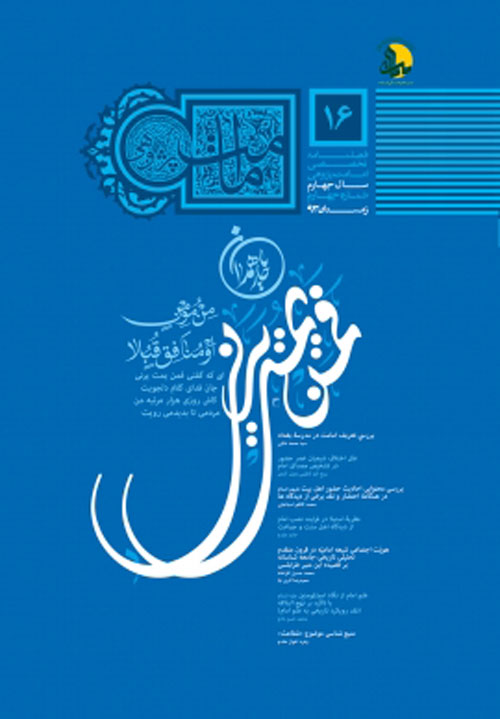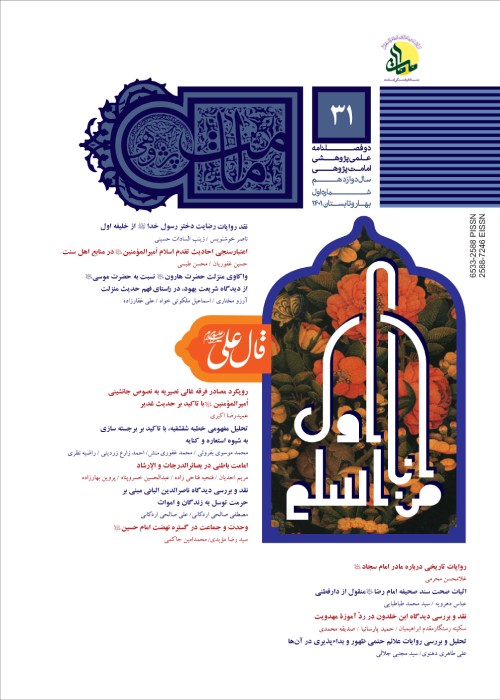فهرست مطالب

نشریه امامت پژوهی
پیاپی 16 (زمستان 1393)
- تاریخ انتشار: 1393/12/10
- تعداد عناوین: 7
- مقالات
-
صفحه 9تعریف امامت، اساس و پایه بحث های امامت پژوهی است. در تفکر شیعه، تعریف سامانمند و منطقی از امامت برای اولین بار از سوی متکلمان مدرسه بغداد مطرح شده است. نویسنده در این نوشتار، تعریف امامت را از دیدگاه مهم ترین شخصیت های مدرسه بغداد موردبررسی قرار داده و ویژگی های این تعاریف و نسبت آن ها با مفهوم نبوت و رسالت از منظر متکلمان مدرسه بغداد و تفاوت این تعاریف را به بحث گذاشته و در پایان به ارزیابی عام رویکرد مدرسه بغداد در تعریف امامت پرداخته است. از نظر نویسنده، به لحاظ روشی، رویکرد متکلمان مدرسه بغداد در تعریف امامت موردپذیرش است، ولی به لحاظ محتوا و جامع ومانع بودن و تناسب آن با معارف قرآنی و روایی در ارتباط با امامت، با اشکالاتی مواجه است. به همین جهت تعریف امامت با توجه به جایگاه آن در قرآن و روایات، نیازمند تکمیل و بازبینی است.کلیدواژگان: تعریف امامت، نبوت، رسالت، مدرسه بغداد، شیخ مفید، سید مرتضی، شیخ طوسی
-
صفحه 43مطالعه تاریخ شیعه در عصر حضور اهل بیت نشان می دهد در زمان شهادت هر یک از ائمه برخی از افراد جامعه شیعی در تشخیص مصداق امام دچار سرگردانی شده و این سرگردانی بستری برای بروز گرایش های مختلف در این خصوص می گردیده است. برخی گفته اند این سرگردانی و اختلافات حاکی از این استدلال باید گفت بر اسامی ائمه است؛ لکن در رد مجعول بودن نصوص داله مخفی بوده است و همین امر بستری این نصوص وجود داشته، اما به دلیل تقیه برای تاثیر سایر عوامل در بروز این اختلافات فراهم کرده است؛ عواملی همچون نقش آفرینی خواص، آموزه های مهدویت و چالش های مرتبط با آن، نوع نگرش جامعه شیعی به ملاک های مطرح در خصوص تشخیص امام و درنهایت فاصله داشتن برخی شیعیان از مرکز رهبری جامعه شیعی.کلیدواژگان: مصداق امام، رهبری جامعه شیعه، تعیین امام، اختلاف شیعیان
-
صفحه 85احادیث حضور اهل بیت علیهم السلام در هنگامه احتضار، در حجم گسترده ای از میراث مکتوب امامیه انعکاس یافته و سند آن ها در نگاه بسیاری از دانشمندان امامیه معتبر است و در گونه شناسی احادیث، در دسته «متواتر معنوی» طبقه بندی می شوند؛ اما از دیرباز درباره محتوای این احادیث، دیدگاه های ناهمگونی وجود داشته است که نمونه آن را در اتخاذ رویکرد تاویلی به این روایات توسط شیخ مفید و سید مرتضی رحمهما الله می توان یافت. بررسی محتوای احادیث احتضار می تواند در برداشت صحیح از آن ها که از سویی بیان گر نتایج فراوان برای محتضر و از سویی دیگر، نشان گر منزلت پیشوایان شیعه است، مفید واقع شود.
در این پژوهش با رویکردی توصیفی_ تحلیلی، با استناد به تصریح واژگان موجود در روایات و شواهد ارائه شده، مشاهده و حضور اهل بیت علیهم السلام در هنگامه احتضار مومن و کافر، ثابت گردیده و دیدگاه های دیگر نقد و بررسی شده است.کلیدواژگان: احتضار، محتضر، حضور اهل بیت علیهم السلام، مقامات امام، مشاهده امام -
صفحه 211مسئله علم امام از دیرباز تاکنون به عنوان یکی از آموزه های اعتقادی و مقومات امامت شیعی مطرح بوده است. این ویژگی که لازمه مرجعیت دینی امامان است، ابتدا توسط شخص پیامبر اکرم صلی الله علیه وآله موردتوجه قرار گرفت و ازآن پس ائمه علیهم السلام و اصحابشان نیز امامت را بر اساس آن بر رسیده اند. در این میان برخی درباره علم امام مطالبی را با رویکرد تاریخی مطرح کرده اند تا نشان دهند باور فعلی شیعیان درباره علم امام، با گذشته، یعنی عصر حضور ائمه علیهم السلام، متفاوت است؛ ازاین رو در این جستار، علم امام و ویژگی های آن از نگاه امام علی علیه السلام با تاکید بر نهج البلاغه که یکی از کهن ترین میراث حدیثی و منابع معرفتی شیعه محسوب می شود، موردبررسی قرار می گیرد تا هم بر علم امام تاکید نماید و هم پاسخی مستند و تاریخی بر شبهاتی باشد که دراین باره مطرح می شود.کلیدواژگان: علم امام، علم غیب، منابع علم امام، امیرالمومنین علیه السلام، نهج البلاغه، شبهات تاریخی
-
صفحه 237
-
Page 9The definition of Imamate serves as the foundation of Imamate studies. Within the Shiite thoughts, a systematic as well as reasonable definition of Imamate was for the first time put forward by the theologians in Bagdad School. In the present study, the researcher has investigated the definition of Imamate from the viewpoint of the most eminent theologians in Bagdad School. He has also dealt with the traits of these definitions along with their relation to the concepts of Prophethood and apostleship through the eyes of the theologians in Bagdad School, while elaborating on the differences among them. And finally, he has conducted a general evaluation of the Bagdad Schools approach to defining Imamate. In researchers view, the approach of Bagdad Schools theologians to defining Imamate is methodologically acceptable; however, it is problematic in terms of content and comprehensiveness as well as its conformity to traditional and Quranic teachings in relation to Imamate. Accordingly, Imamate needs to be completely defined and likewise redefined. And this should be accomplished with respect to the position of Imamate in the Quran and traditions as well as the related concepts of Imamate employed in the Shiite thought.Keywords: The definition of Imamate, prophethood, apostleship, Bagdad School, Sheikh Mofid, Seyyed Morteza, Sheikh Tousi
-
Page 43Surveying the history of Shia in the very time of Ahl-al-Bayit(The family of the prophet) ,shows that, when every one of them was martyred, some of the people in the Shiite society were left with perplexity in recognizing the referent of the Imam, leading to the emergence of varied tendencies in this regard. Some have said these perplexities and disconformities represent the forgery of the texts indicative of the names of Imams. However, to reject this reasoning, one can say there is another hypothesis, claiming these texts had already existed but were concealed due to dissimulation (Taqieh). And this has established the ground for the other parameters to affect the emergence of these disagreements. These parameters include the role of the elites; the teachings of Mahdiism and its related challenges; the kind of the Shiite communitys attitude towards the available criteria for recognizing the referent of Imam; and finally, the existing distance between some Shiites and the leadership center of Shiite community.Keywords: The referent of Imam, Shiite community's leadership, the appointment of Imam, Shiite's disagreements
-
Page 85The traditions indicating the presence of Ahl al Bayt(PBHT) at the premortem time have widely been reflected within the written literature of Imamiyah, with their authenticity of documentation being unanimously agreed upon by Imamiyah scholars. Moreover, these traditions are classified as possessing Tawatur(succession) of the content according to the typology of traditions. However, there have long been different approaches to the content of these traditions, one sample of which could be found in adopting an interpretive approach to these traditions by Sheikh Mofid and Seyyed Morteza( May both rest at peace). Examining the content of the premortem time traditions can be advantageous to an accurate interpretation of these them. This can both indicate the many positive outcomes for the person experiencing the premortem time and represent the high status of Shiite Imams. Employing a descriptive-analytic approach, the prevent study cites the affirmation of the available words within the traditions as well as the presented evidences to prove the presence of Ahl al Bayt(PBUT) and their being observed at the premortem time of both believers and nonbelievers. Finally, the other outlooks have also been investigated and criticized.Keywords: Premortem time, a person at the premortem time, the presence of Ahl al Bayt, Imam's status, observing Imam
-
Page 119Three methods have been proposed in the Sunni (people of tradition and consensus) thought for designating the ruler as well the establishment of the government, namely, the selection made by the scholars of Islamic Law; vicegerency; and violence and dominance. Some Sunnis have unconditionally approved of the method of violence and dominance to designate the ruler, citing some traditions and the life of some companions of the Prophet. Whereas, it appears that this approach contradicts the verses of the Koran, prophetic traditions and the life of some great companions and successors. To approve of the method of violence and dominance, some other Sunni thinkers have resorted meaning the inevitable, ÇáÖÑæÑÇÊ ÊõÈیÍ ÇáãÍÙæÑÇÊ to the principle of, áÇ ÖÑÑ make the forbidden permissible; as well as the principle meaning no harm. Yet, it seems that citing these principles is also incomplete. Besides, the Mutazilites did not approve of this method of designating Imams either. Accordingly, the present study has sought to analyze and evaluate the proofs the Sunnis cite to approve of the method of violence and dominance within their traditional thought.Keywords: Designating the ruler, violence, dominance, people of tradition, consensus (Sunnis)
-
Page 153Both the fourth and fifth centuries are considered as the era of the political-religious power and dominance of Shiism over the world of Islam. Shiites geographical expansion throughout the world of Islam, accompanied by the political support of the two states of Buyid Dynasty in Baghdad and the Fatimids in Egypt and Shamat(The Levant) region, allowed Shiites to both freely express their beliefs and perform many of their rites. According to the bipolar conflict theory in sociology, investigating Shiites doctrinal-social status, based on the texts and reports indicating Shiite-Sunni confrontations of identity, could be one of the sources for the social-historical analysis of those times. One of the important sources in this regard is the famous balladry by Ibn-e-Monir Tripoli named Ttryh, in which these clashes of identity are well depicted. Ibn-e-Monir, being impressed by an incident occurred between him and one of the then grandees in to Sharif, in which he pictured a host of beliefs and confrontations present in the then society. The range of the issues posed in this poem, including doctrinal beliefs, ritual inconsistencies and practical issues (namely jurisprudential), shows all the confrontations present at that time. Examining the verses of this poem, the present study seeks to first demonstrate the origin of Shiite beliefs and rites passed down by Ahl al Bayt (Family of the Prophet); and second, point out the historical evidences and the existence of disconformity among the Islamic sects of the then society, especially in Baghdad as the residence of Sharif and Shamat and Egypt as the residence of Ibn-e- Monir.Keywords: The balladry of Ttryh Ibn e, Monir Tripolis, the Identity of Imamiyah Shia, bipolar conflict
-
Page 211The issue of Imams knowledge, as one of the doctrinal teachings and potencies of Shiite Imamate, has long been under the spotlight. Serving as a requirement for the religious authority of Imams, this trait was first considered by the prophet (PBUH) of Islam. Then, it was also the basis of investigating Imamate by Imams (PBUT) and their disciples. Their opinions and views have been mentioned in the traditional sources including Nahj al Balagha, as one of the first sources of Shiite knowledge. Some have posed several arguments with a historical approach to prove that the present Shiite beliefs in Imams knowledge are different from those of the past, that is, the time of Imams. Hence, the present research seeks to investigate Imams knowledge and its characteristics from the viewpoint of Imam Ali (PBUH). The investigation is conducted with an emphasis on Nahj al Balagha, which is one of the oldest legacies of tradition, both to emphasize the fundamental strength of Imams knowledge and to provide a documentary and historical answer to doubts cast in this regard.Keywords: Imam's knowledge, knowledge of unseen, the sources of Imam's knowledge, commander of the faithful, Nahj al Balagha, historical doubts


